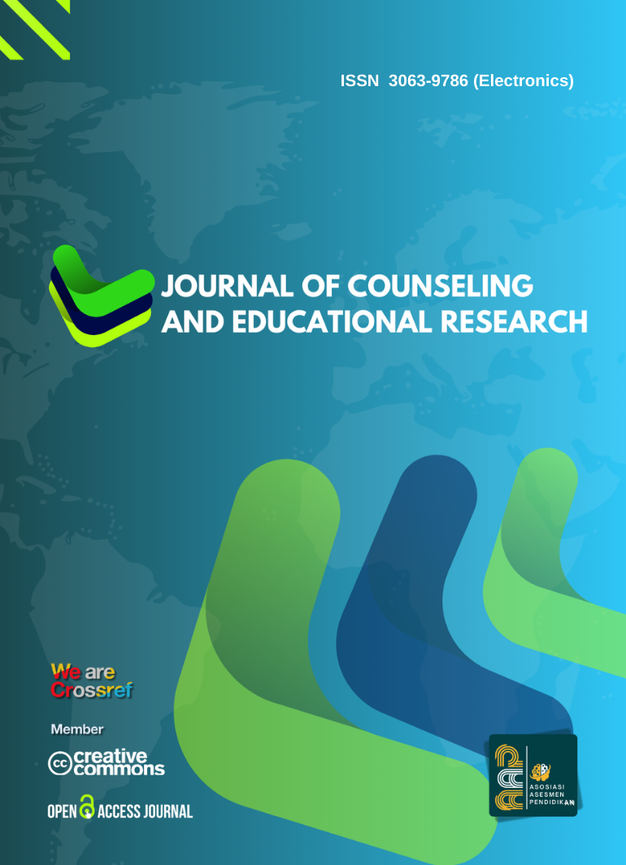The relationship between the use of technology in learning and student self-efficacy
-
Published: August 25, 2024
-
Page: 44-50
Abstract
Information technology and self-efficacy in learning activities are very important, because information technology is a process that can help to make it easier to access and obtain the desired scientific information. The aim of the research is to determine the level of technology use in learning and the level of student self-efficacy and to examine the relationship between the use of technology in learning and student self-efficacy. The method applied in this research adopts a quantitative approach with a correlational type. This study had 34 samples determined using random sampling techniques. The research results show that the level of skills in using technology in learning and students' self-efficacy are generally in the medium category. Then it can be seen that the correlation between variables does not show a significant correlation.
- Student technology literacy
- Self-efficacy
- Information and communication technology
- Amelia, R. P., Filiani, R., & Herdi, H. (2014). Self-efficacy terhadap Penggunaan dalam Layanan Bimbingan dan Konseling Pada Guru BK / Konselor SMAN Jakarta Pusat. Insight Jurnal, 3(1), 106–110. https://doi.org/10.21009/INSIGHT.031.18
- Aprima, D., & Sari, S. (2022). Analisis Penerapan Pembelajaran Berdiferensiasi Dalam Implementasi Kurikulum Merdeka Pada Pelajaran Matematika SD. Cendikia : Media Jurnal Ilmiah Pendidikan, 13(1), 95–101.
- Dhianti, L. (2021). Efektivitas Blended Learning Berbasis LMS dalam Pembelajaran Matematika. Jurnal Riset Pembelajaran Matematika Sekolah, 5(1), 80–84. https://doi.org/10.21009/jrpms.051.10
- Emzir (2008), Metodologi Penelitian Pendidikan_Kuantitatif & Kualitatif (Korelasional, Eksperimen, Ex Post Facto, Etnografi, Grounded Theory, Action Research,. Jakarta: Rajagrafindo Persada.
- Halimah, N., Hadiyanto, H., & Rusdinal, R. (2023). Analisis Pembelajaran Berdiferensiasi Sebagai Bentuk Implementasi Kebijakan Kurikulum Merdeka. Jurnal Ilmiah Pendiodikan Dasar, 8(1), 5019–5033. https://doi.org/10.23969/jp.v8i1.7552
- Kennedy, D. M., & Fox, B. (2013). “Digital natives”: An Asian perspective for using learning technologies. International Journal of Education and Development Using Information and Communication Technology (IJEDICT), 9(1), 64–79. http://www.ugc.edu.hk/eng/ugc/policy/policy.htm
- Munawaroh, I. (2010). Pemanfaatan Teknologi Informasi Dan Komunikasi Untuk Menumbuhkan Kreativitas Dan Kemandirian Belajar. Jurnal Teknologi Informasi Dan Komunikasi, 1–10. http://staff.uny.ac.id/sites/default/files/pemanfaatan teknologi informasi dan komunikasi untuk menumbuhkan kreativitas dan kemandirian belajar di sekolah.pdf
- Ningrum, M., Maghfiroh, & Andriani, R. (2023). Kurikulum Merdeka Belajar Berbasis Pembelajaran Berdiferensiasi di Madrasah Ibtidaiyah. EL Bidayah: Journal of Islamic Elementary Education, 5(1), 85–100. https://doi.org/10.33367/jiee.v5i1.3513
- Prabowo, R. A., Hita, I. P. A. D., Lubis, F. M., Patimah, S., Eskawida, E., & Siska, S. (2023). Pengaruh Motivasi Terhadap Hasil Belajar Dribbling Permainan Bola Basket. Journal on Education, 5(4), 12648–12658. https://doi.org/10.31004/joe.v5i4.2253
- Savira, F., & Suharsono, Y. (2013). Virtual Learning: Pemanfaatan Teknologi Informasi Dan Komunikasi Untuk Meningkatkan Kualitas Pembelajaran. Journal of Chemical Information and Modeling, 1(1), 1689–1699.
- Turner, A. (2015). Generation Z: Technology and Social Interest, Journal Individual Psychology, 71(2), 103–113. https://doi.org/10.1353/jip.2015.0021
- Wahyuningsari, D., Mujiwati, Y., Hilmiyah, L., Kusumawardani, F., & Sari, I. P. (2022). Pembelajaran Berdiferensiasi Dalam Rangka Mewujudkan Merdeka Belajar. Jurnal Jendela Pendidikan, 2(04), 529–535. https://doi.org/10.57008/jjp.v2i04.301
- Warisno, A. (2022). Konsep Mutu Pembelajaran dan Faktor-Faktor yang Mempengaruhinya. Attractive : Innovative Education Journal, 4(1), 1–12. https://doi.org/10.51278/aj.v4i1.442












